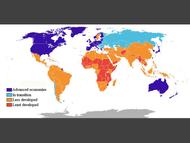Emissions or Equity?
- By:
- Edward A. Reid Jr.
- Posted On:
- May 14, 2019 at 6:00 AM
- Category
- Climate Change
The first argument of the consensed climate science community is that global “greenhouse gas” emissions must be reduced to avoid a potential future climate catastrophe if the global average near-surface temperature increase exceeds 1.5°C or 2°C. This argument logically leads to the conclusion that all nations must stop increasing their annual “greenhouse gas” emissions and begin reducing them rapidly towards zero net annual emissions. This logic, while scientifically sound, is judged to be philosophically unsound.
The alternative argument is that developing nations and not-yet-developing nations must be allowed to continue to increase their “greenhouse gas’ emissions to support their continued economic development. The major advocates of this position are China and India, both of which have refused to agree to halt the growth of their emissions until at least 2030. This position is supported by the majority of the members of the Group of 77 developing countries.
The UN, through both the UNFCCC and the IPCC, finds itself on both sides of the issue. In the meantime, global annual “greenhouse gas” emissions continue to rise; and, therefore, global atmospheric “greenhouse gas” concentrations continue to rise as well. The increase in atmospheric “greenhouse gas” emissions cannot be halted until the reductions in emissions by numerous countries match or exceed the annual increases in emissions by numerous other countries. Correspondingly, the increase in atmospheric “greenhouse gas” concentrations cannot be halted until all nations cease adding “greenhouse gases” to the atmosphere.
Therefore, even if the US aggressively pursued the climate change aspects of the “Green New Deal” (GND), global annual atmospheric “greenhouse gas” emissions would continue to increase until the rate of decrease of emissions by the US and other countries decreasing their emissions equaled the rate of increase of emissions by developing and not-yet-developing countries increasing their annual emissions. Global annual “greenhouse gas” emissions would then stabilize and perhaps begin to decline.
However, the atmospheric concentration of “greenhouse gases” would not stabilize until all nations achieved net-zero annual emissions, which is not likely to happen until mid-century, since neither China nor India plans to cease increasing their annual emissions until at least 2030, if then. China is also providing coal generation facilities to a number of other countries, which would also continue to increase their annual emissions as their economies grow.
Of course, it is not possible to accurately estimate the ultimate “greenhouse gas” concentrations which would be reached because most nations’ commitments to reducing emissions are not firm, nor are other nations’ intentions to increase emissions. It is also not possible to accurately estimate the additional increases in the global temperature anomaly which would supposedly result from these increased emissions, since the current climate models do not accurately model the real climate.
In this atmosphere of continued uncertainty, we can expect to continue to be provided with projections of potential future scary scenarios. However, we can expect that these scenarios would be based on our progress in achieving reductions in our emissions, rather than on the lack of progress by developing and not-yet-developing nations.
It would seem that, at least in the minds of some in the consensed climate science community, climate “justice” is more important than climate catastrophe avoidance. If they prevail and we experience a climate catastrophe, at least it would be a “just” catastrophe.
Makes you feel warm all over, doesn’t it?


